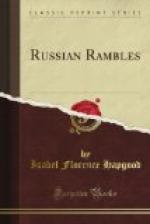During the next three quarters of a mile the houses and shops are more city-like, and, being newer than those beyond, are more ornamented as to the stucco of their windows and doors. Here, as elsewhere in this stoneless land, with rare exceptions, the buildings are of brick or rubble, stuccoed and washed, generally in light yellow, with walls three feet or more apart, warmly filled in, and ventilated through the hermetically sealed windows by ample panes in the centre of the sashes, or by apertures in the string-courses between stories, which open into each room. Shops below, apartments above, this is the nearly invariable rule.
It is only when we reach the Anitchkoff Bridge, with its graceful railing of sea-horses, adorned with four colossal bronze groups of horse-tamers, from the hand of the Russian sculptor, Baron Klodt, that the really characteristic part of the Nevsky begins.
It is difficult to believe that fifty years ago this spot was the end of the Petersburg world. But at that epoch the Nevsky was decorated with rows of fine large trees, which have now disappeared to the last twig. The Fontanka River, or canal, over which we stand, offers the best of the many illustrations of the manner in which Peter the Great, with his ardent love of water and Dutch ways, and his worthy successors have turned natural disadvantages into advantages and objects of beauty. The Fontanka was the largest of the numerous marshy rivers in that Arctic bog selected by Peter I. for his new capital, which have been deepened, widened, faced with cut granite walls, and utilized as means of cheap communication between distant parts of the city, and as relief channels for the inundating waves of the Gulf of Finland, which rise, more or less, every year, from August to November, at the behest of the southwest gale. That this last precaution is not superfluous is shown by the iron flood-mark set into the wall of the Anitchkoff Palace, on the southern shore of the Fontanka, as on so many other public buildings in the city, with “1824” appended,—the date of one celebrated and disastrous inundation which attained in some places the height of thirteen feet and seven inches. This particular river derived its name from the fact that it was trained to carry water and feed the fountains in Peter the Great’s favorite Summer Garden, of which only one now remains.
At the close of the last century, and even later, persons out of favor at Court, or nobles who had committed misdemeanors, were banished to the southern shores of the Fontanka, as to a foreign land. Among the amusements at the datchas,—the wooden country houses,—in the wilder recesses of the vast parks which studded both shores, the chase after wild animals, and from bandits, played a prominent part.




